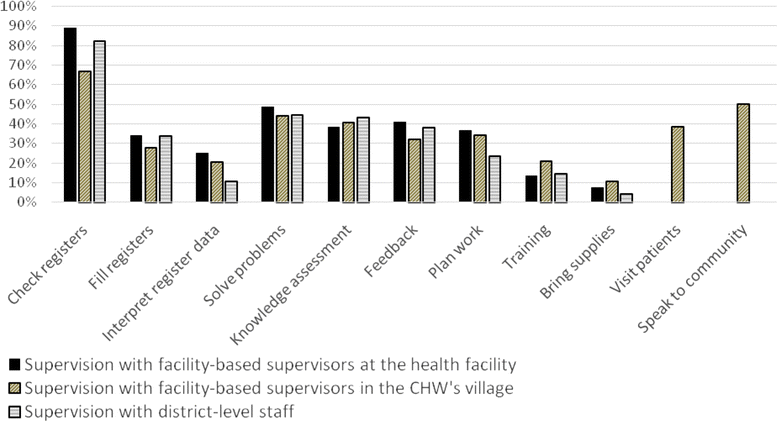Initial experiences and innovations in supervising community health workers for maternal, newborn, and child health in Morogoro region, Tanzania
- PMID: 25880459
- PMCID: PMC4403773
- DOI: 10.1186/s12960-015-0010-x
Initial experiences and innovations in supervising community health workers for maternal, newborn, and child health in Morogoro region, Tanzania
Abstract
Background: Supervision is meant to improve the performance and motivation of community health workers (CHWs). However, most evidence on supervision relates to facility health workers. The Integrated Maternal, Newborn, and Child Health (MNCH) Program in Morogoro region, Tanzania, implemented a CHW pilot with a cascade supervision model where facility health workers were trained in supportive supervision for volunteer CHWs, supported by regional and district staff, and with village leaders to further support CHWs. We examine the initial experiences of CHWs, their supervisors, and village leaders to understand the strengths and challenges of such a supervision model for CHWs.
Methods: Quantitative and qualitative data were collected concurrently from CHWs, supervisors, and village leaders. A survey was administered to 228 (96%) of the CHWs in the Integrated MNCH Program and semi-structured interviews were conducted with 15 CHWs, 8 supervisors, and 15 village leaders purposefully sampled to represent different actor perspectives from health centre catchment villages in Morogoro region. Descriptive statistics analysed the frequency and content of CHW supervision, while thematic content analysis explored CHW, supervisor, and village leader experiences with CHW supervision.
Results: CHWs meet with their facility-based supervisors an average of 1.2 times per month. CHWs value supervision and appreciate the sense of legitimacy that arises when supervisors visit them in their village. Village leaders and district staff are engaged and committed to supporting CHWs. Despite these successes, facility-based supervisors visit CHWs in their village an average of only once every 2.8 months, CHWs and supervisors still see supervision primarily as an opportunity to check reports, and meetings with district staff are infrequent and not well scheduled.
Conclusions: Supervision of CHWs could be strengthened by streamlining supervision protocols to focus less on report checking and more on problem solving and skills development. Facility health workers, while important for technical oversight, may not be the best mentors for certain tasks such as community relationship-building. We suggest further exploring CHW supervision innovations, such as an enhanced role for community actors, who may be more suitable to support CHWs engaged primarily in health promotion than scarce and over-worked facility health workers.
Figures
Similar articles
-
Engaging community health workers in maternal and newborn care in eastern Uganda.Glob Health Action. 2015 Mar 31;8:23968. doi: 10.3402/gha.v8.23968. eCollection 2015. Glob Health Action. 2015. PMID: 25843491 Free PMC article.
-
Profile, knowledge, and work patterns of a cadre of maternal, newborn, and child health CHWs focusing on preventive and promotive services in Morogoro Region, Tanzania.Hum Resour Health. 2015 Dec 24;13:98. doi: 10.1186/s12960-015-0086-3. Hum Resour Health. 2015. PMID: 26703439 Free PMC article.
-
Supportive supervision and constructive relationships with healthcare workers support CHW performance: Use of a qualitative framework to evaluate CHW programming in Uganda.Hum Resour Health. 2018 Feb 13;16(1):11. doi: 10.1186/s12960-018-0272-1. Hum Resour Health. 2018. PMID: 29439743 Free PMC article.
-
Sources of community health worker motivation: a qualitative study in Morogoro Region, Tanzania.Hum Resour Health. 2013 Oct 10;11:52. doi: 10.1186/1478-4491-11-52. Hum Resour Health. 2013. PMID: 24112292 Free PMC article. Review.
-
Community health workers' experiences of supervision in maternal and child health programmes in low- and middle-income countries: A qualitative evidence synthesis.Health Soc Care Community. 2022 Nov;30(6):2170-2185. doi: 10.1111/hsc.13893. Epub 2022 Jul 19. Health Soc Care Community. 2022. PMID: 35852501 Review.
Cited by
-
How to create more supportive supervision for primary healthcare: lessons from Ngamiland district of Botswana: co-operative inquiry group.Glob Health Action. 2016 Jun 24;9:31263. doi: 10.3402/gha.v9.31263. eCollection 2016. Glob Health Action. 2016. PMID: 27345024 Free PMC article.
-
Supportive supervision of close-to-community providers of health care: Findings from action research conducted in two counties in Kenya.PLoS One. 2019 May 29;14(5):e0216444. doi: 10.1371/journal.pone.0216444. eCollection 2019. PLoS One. 2019. PMID: 31141509 Free PMC article. Clinical Trial.
-
Gender intentional approaches to enhance health social enterprises in Africa: a qualitative study of constraints and strategies.Int J Equity Health. 2021 Apr 10;20(1):98. doi: 10.1186/s12939-021-01427-0. Int J Equity Health. 2021. PMID: 33838679 Free PMC article.
-
Transition and change: opportunities and challenges of CHW programme reform for community health systems and vertical disease programmes in Liberia.Health Res Policy Syst. 2024 Oct 7;22(1):141. doi: 10.1186/s12961-024-01211-w. Health Res Policy Syst. 2024. PMID: 39375677 Free PMC article.
-
Iterative Development of a Mobile Phone App to Support Community Health Volunteers During Cervical Cancer Screening in Western Kenya: Qualitative Study.JMIR Form Res. 2022 Feb 24;6(2):e27501. doi: 10.2196/27501. JMIR Form Res. 2022. PMID: 35200151 Free PMC article.
References
-
- Lewin SA, Dick J, Pond P, Zwarenstein M, Aja G, van Wyk B, Bosch-Capblanch X, Patrick M. Lay health workers in primary and community health care. Cochrane Database Syst Rev 2005:CD004015. - PubMed
-
- Lehmann U, Sanders D. Community health workers: what do we know about them? Geneva: World Health Organization, Evidence and Information for Policy, Department of Human Resources for Health; 2007. pp. 1–34.
-
- Winch PJ, Bhattacharyya K, Debay M, Sarriot EG, Bertoli SA, Morrow RH. Improving the performance of facility- and community-based health workers. Calverton, MD: Child Survival Technical Support Project, ORC Macro; 2003. pp. 1–62.
Publication types
MeSH terms
LinkOut - more resources
Full Text Sources
Other Literature Sources


